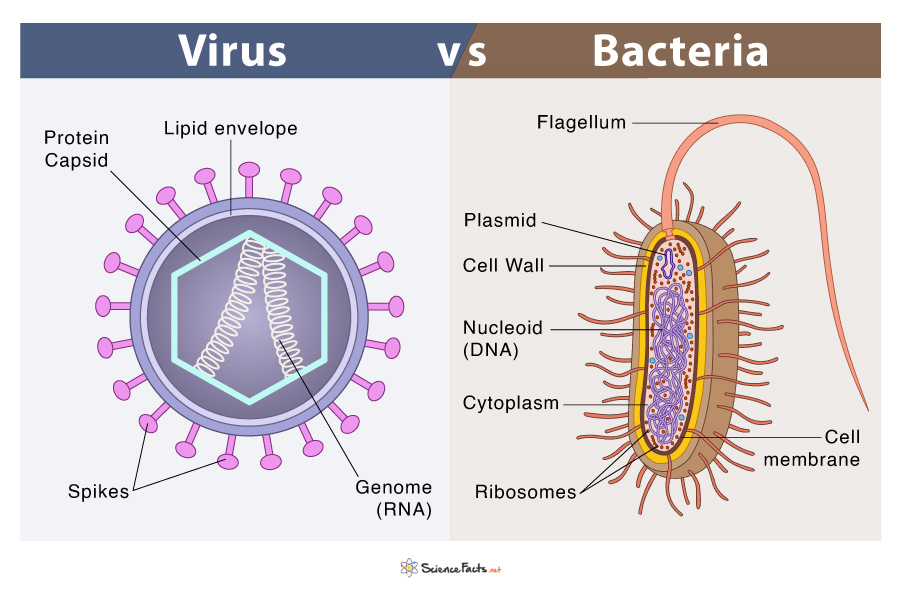Virus vs Bacteria
Viruses and bacteria are microscopic organisms. They may not be visible by naked eyes, but millions of them surround us all.
Viruses are an assembly of different molecules containing genetic material. Most biologists do not consider them living, as they need to enter a host cell to survive and reproduce. However, they are also quite selective about their hosts.
Bacteria are the smallest and simplest microbes with a free-floating genetic material. They are abundant in soil, inhabiting plant root systems to help them in nitrogen-fixation. Also, within the human body, they inhabit the digestive system to aid in energy metabolism and digestion.

Compare and Contrast
Though both of them are microbes and cause serious harm to the living world, they are pretty different in their structure, composition, and mode of action. So let us discuss their differences.
What Is the Difference between Virus and Bacteria
| Basis | Virus | Bacteria |
| 1. Living or Nonliving | Non-living, can only replicate within a host cell. | Living organism, can replicate independently or inside a host cell. |
| 2. Cell Type | Do not qualify as cells. So, they are neither prokaryotic nor eukaryotic. | Consist of a single prokaryotic cell. |
| 3. Structure | Composed of a protein coat (capsid) that contains the genetic material (nucleic acid). | Composed of cell organelles. DNA immersed within the cytoplasm and surrounded by a cell wall. |
| 4. Size | Smaller than bacteria. Typically range in size between 20 to 400 nm in diameter. | Larger than viruses. Typically range in size between 200 to 1000 nm in diameter. |
| 5. Shape | Can be polyhedral, spherical, or helical. | Can be spherical (cocci), rod-shaped (bacilli), comma-shaped (vibrio), or spiral. |
| 6. Cells They Infect | Can infect both plant and animal cells (plant virus and animal virus). They can even infect a bacterial cell (bacteriophage or phage virus). | Can infect both plant and animal cells. |
| 7. Visibility Under Microscope | Visible under the electron microscope. | Visible under the light microscope. |
| 8. Reproduction | Insert their genetic material into the host genome and produce multiple copies. | Undergo asexual reproduction by binary fission. They can also reproduce by exchanging their genetic material by conjugation. |
| 9. Host Dependence | Host-dependent | Host-independent |
| 10. Genome & Nucleic Acid | Have either DNA or RNA as their genetic material. | Have a free-floating single chromosome of the circular double-stranded DNA helix (plasmid). The area of the cell that contains the DNA is called the nucleoid. |
| 11. Replication | Replicate within the host cell by hijacking its cellular machinery. | Replicate through binary fission. |
| 12. Cell Organelles | Lack a nucleus, ribosomes, or any other cell organelles. Instead, it only contains a membrane known as an envelope, made of phospholipids. | Cell organelles, such as cell walls, ribosomes, and cell membranes, are present in bacteria, except the nucleus. |
| 13. Outer wall | Do not contain a cell wall. Instead, the genetic material is encased by a protein coat (known as a capsid) or a fat layer. | The cell wall is made of peptidoglycan and sometimes lipopolysaccharides. |
| 14. Type of Infections Caused | Generally systemic infections, i.e., affecting the entire body, rather than a single organ or body part. For example, measles, influenza, and flu. | Generally localized infection, i.e., an infection that is limited to a specific part of the body and has local symptoms. For example, pneumonia, tuberculosis, food-poisoning. |
| 15. Common Diseases Caused | Measles, rubella, chickenpox/shingles, roseola, smallpox, chikungunya, and mumps. | Cholera, leprosy, tuberculosis, plague, syphilis, anthrax. |
| 16. Treatment | Not cured by antibiotics. Antiviral drugs block some but not all viruses from entering the body or stop them from reproducing. | Cured by antibiotics. |
| 17. Examples | Coronavirus, Human immunodeficiency virus (HIV), Influenza virus, Herpes virus, Human papillomavirus (HPV). | Escherichia coli, Salmonella Typhi, Vibrio cholera, Streptococcus pneumonia, and Lactobacillus acidophilus. |
What Do Viruses and Bacteria Have in Common
Although vastly different from each other, both bacteria and viruses share some common features. They are given below:
- No membrane-bound organelles.
- Microscopic
- Causes disease
- Carry genetic material
- Can spread through coughing, sneezing, or coming into contact with contaminated surfaces, animals, items, or people.
- Can be treated with vaccines
-
References
Article was last reviewed on Monday, October 11, 2021



